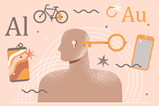Discover how to successfully transfer lesson observation feedback from one context to another to improve your practice

Imagine the scenario: you have had a lesson observation when you were teaching rates of reaction, doing a practical with different concentrations of hydrochloric acid and limestone chips. The feedback focused on how to manage practical conditions and contained a reminder to be consistent with the use of language because you occasionally slipped into saying strength of acid instead of concentration.
However, unless you will be observed again teaching the same lesson, you’ll have to transfer this feedback to a completely different context. Say the observer is going to do a follow-up observation of you introducing the concept of life cycle assessments. How do you transfer the feedback from the previous lesson and, more pertinently, can you? The challenges of teaching life cycle assessments may be unknown to a teacher who is yet to teach it, and transferring feedback from a completely different context could well be unhelpful when lesson planning.
Context is key
This is an inherent weakness of lesson observation, unless you are considering how well the observed teacher can transfer feedback to different contexts. For student teachers, this transfer will be even harder to achieve, due to their early-career views on teaching and developing knowledge of how to teach. Transfer between contexts is an important part of professional development or training to become a teacher, but we can sometimes apply the concepts of transfer.
In an article about getting the most out of lesson observation, I suggest that the classroom is a complex learning environment with many variables. The result is that it’s often a challenge to identify the specific effect of an intervention in a lesson. This is where an understanding of the near/far model of transfer can help develop teaching practice and positively impact students, because successful transfer requires an understanding of the mechanisms required to make an improvement.
Most of the feedback could be spent on co-planning the next lesson
In transfer, we consider the ability to use acquired knowledge to solve novel problems. In near transfer the novel issue is usually within the same subject domain and is easier to achieve than far transfer, when the transfer occurs across different subject domains. In our lesson observation scenario, the feedback about managing a practical might not have any relevance to the lesson on life cycle assessments. This is an example of feedback aiming for far transfer but also eschews the coaching model of providing feedback that the recipient can use to plan and practise. So, it’s hard to learn from this experience. While it’s an example of an intervention (the lesson observation) that might involve an interesting conversation, it is not about focused and successful professional development.
But we can use the concept of transfer to our advantage in two situations: lesson observations and lesson planning.
Lesson observations and feedback
The feedback at the end of a lesson should acknowledge what’s gone on in the lesson. In our scenario, the feedback specified the practical could have been improved and the teacher could have been more consistent with their terminology. Of the two pieces of feedback, the consistent use of terminology is easier to plan for and practise in the next lesson on life cycle assessment, and could be seen as near transfer. If the lesson could be taught again, then the tweaks for the practical would be an example of near transfer. If the feedback was applied to a different practical, then this would be an example of far transfer.
To improve the feedback process for the recipient, and ensure their professional development is central to the lesson observation process, most of the feedback could be spent on co-planning the next lesson. This would mean the focus of the conversation is on something that will be taught next. There would be a shared understanding of how the feedback will be applied in the next lesson and the benefit to both teacher and students would be more tangible.
Successful transfer
Use these two simple tips to guarantee effective transfer:
- Acknowledge how straightforward it is to transfer feedback to the next lesson.
- Check that there is a shared understanding of the feedback, clearly identifying mechanisms for development.
Lesson planning
Students can also benefit if their teacher has a deeper understanding of near and far transfer. It could help them avoid one of the most common errors in teaching: demonstrating a concept on the board but then giving out questions that differ from how it was explained. For example, a teacher has introduced the concept of calculating relative atom mass and relative formula mass. They show an example on the board and talk it through with students. They then give a second example on the board and question students to find the answer. Finally, they hand out a worksheet with questions which are worded differently and bare no relation to anything they have learned in the lesson. The students have not had the chance to think for themselves about the concept, so hands start rising as they struggle to answer the questions.
The solution is simple: provide questions that are very similar to what’s on the board. Give lots of examples so students can use the processes they’ve been taught and start to develop a fluency. To promote far transfer, understand that the students don’t need to do this by themselves. If you are going to put a more challenging problem on the board, model this with them and help them to recognise and flexibly apply the relevant parts of the previously learned procedure. Helping students understand when and why to apply what they already know to the new situation supports the far transfer.
If we recognise that transferring knowledge and skills across domains is cognitively challenging, we can avoid giving feedback that is difficult to act on. Such feedback has limited effectiveness. We can also better support our students, reducing that mass of hands shooting up, or ensuring they’re not struggling to apply what they know to a new concept or problem.
Dom Shibli is a teacher trainer














No comments yet